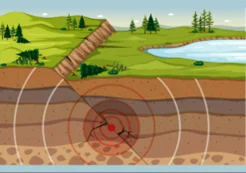-
16 Aug 2023
GS Paper 1
Geography
Day 27: Define land subsidence and outline the factors leading to its occurrence in the Himalayan region. (150 words)
- Define land subsidence.
- Discuss its reasons of occurrence in Himalaya region.
- Conclude suitably.
Answer:
According to the National Oceanic and Atmospheric Administration (NOAA), subsidence is the “sinking of the ground because of underground material movement”.
- It can happen for a host of reasons, man-made or natural, such as the removal of water, oil, or natural resources, along with mining activities.
- Earthquakes, soil erosion, and soil compaction are also some of the well-known causes of subsidence.
- Reasons for land subsidence in Himalaya region:
Natural causes:
- Tectonic Activities: The Himalayas are a seismically active region due to the collision of the Indian and Eurasian tectonic plates. Earthquakes and faulting can cause the ground to deform and settle, leading to land subsidence.
- For instance, the 2015 Gorkha earthquake in Nepal resulted in significant land subsidence in the affected regions.
- Glacial Melting: The Himalayan region is experiencing rapid glacial melting due to climate change. As glaciers recede, the weight they previously exerted on the land decreases, leading to land subsidence.
- For example, in parts of Nepal, glacial melting has contributed to the sinking of land in the surrounding areas.
- Climate-Induced Changes: Changes in precipitation patterns and increased rainfall intensity can affect the stability of the land and contribute to land subsidence.
- Example: Heavy rainfall events, particularly during the monsoon season, can trigger landslides and soil erosion, causing land subsidence in hilly regions of the Himalayas.
- Cloudbursts are one of the main causes of landslides in Uttarakhand.
- Example: Heavy rainfall events, particularly during the monsoon season, can trigger landslides and soil erosion, causing land subsidence in hilly regions of the Himalayas.
Anthropogenic causes:
- Groundwater Extraction: Excessive extraction of groundwater for various purposes, such as irrigation and urbanization, can cause land subsidence.
- Example: In the Indo-Gangetic plains of the Himalayan region, rapid urbanization and agricultural expansion have led to excessive groundwater extraction, resulting in significant land subsidence.
- Mining Activities: Unplanned and unregulated mining operations in the Himalayan region can cause land subsidence due to the removal of materials from the Earth's crust.
- Example: In areas like Jharia in Jharkhand, extensive underground coal mining has resulted in land subsidence, leading to sinkholes and ground instability.
- Urbanization and Infrastructure Development: Rapid urbanization and construction of large infrastructures, such as dams and roads, can also contribute to land subsidence. The weight of heavy structures and buildings can compress underlying soil, causing the land to sink.
- An example can be seen in some urban centers in the Himalayan region experiencing subsidence due to infrastructure development.
- The recent Joshimath land subsidence was fueled by the rampant infrastructural development in the region.
- An example can be seen in some urban centers in the Himalayan region experiencing subsidence due to infrastructure development.
Measures to tackle land subsidence in the Himalayan region:
- Sustainable Water Management: Implementing efficient water management practices, such as rainwater harvesting and water recycling, can help reduce excessive groundwater extraction and alleviate subsidence.
- Monitoring and Early Warning Systems: Setting up monitoring networks to track ground movements and seismic activity can provide early warning of potential subsidence and earthquake-related hazards.
- Regulating Mining and Resource Extraction: Enforcing strict regulations on mining activities and resource extraction to prevent the creation of voids underground can mitigate land subsidence risks.
- Climate Change Mitigation: Taking measures to address climate change, such as reducing greenhouse gas emissions and promoting sustainable practices, can slow down glacial melting and mitigate associated subsidence.
- Responsible Urban Planning: Adopting responsible urban planning and considering soil stability in infrastructure projects can minimize the impact of human activities on land subsidence.
- Integrating infra development with landslide susceptibility maps: The Bhukosh web portal developed by the Geological Survey of India (GSI) has the landslide susceptibility maps and landslide inventory data of landslide-prone areas in the country.
- This data can be used to identify areas that are at high risk of landslides, and to plan infrastructure and development in these areas in a way that minimizes the risk of disasters.
By understanding the factors contributing to land subsidence in the Himalayan region and implementing appropriate measures, it is possible to mitigate its impact and promote sustainable development in the area.





